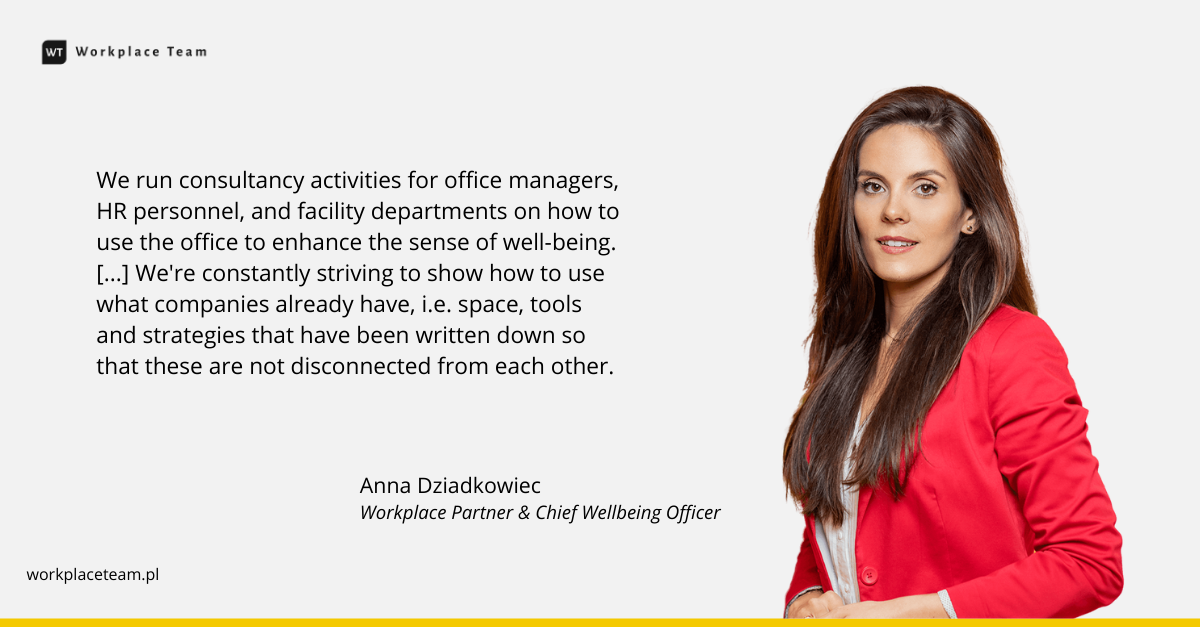
A wellbeing workspace – what is it and how to approach it strategically
As a rule, wellbeing is associated by employers with high costs and the need to constantly ‘stroke’ the employee with various types of benefits (possibly a certain obligation to be taken up in the era of discussions on ESG, Diversity & Inclusion and Employee Experience). Unfortunately, it frequently turns out that, despite a range of benefits, employees do not feel well in their workplace at all. On the contrary, they feel deeply misunderstood and undervalued. As a result, both parties experience frustration, until a decision is made within the company: no more benefits from now on. However, to take proper care of the employees’ well-being, it is necessary to find the source of the problem. So, what is really well-being? Where did we go wrong? What can we as an organisation offer our employees? And how does the workspace affect their well-being? Read on to find out!
Well-being is not (just) about benefits
In a well-being workplace, the list of benefits does not have to be two pages long. It can be very short, but it should be based on thinking about people and their needs – namely both health and mental needs. It does not matter if it is an ordinary worker, a manager or a director – we are all human beings! However, depending on our life situation, we perceive and articulate our needs differently. A well-being organisation should take them all into account, prioritising the quality of the services provided and the fit with the audience, i.e. its employees. Real people. Not statistical ‘millennials’.
Well-being is therefore not just an internal benefits policy. It is a strategy that allows a company to achieve an appropriate level of efficiency in its operations, respecting the resources available, by nurturing well-being and awareness among its employees. It is about giving people the opportunity to realise their needs, without necessarily doing it for them. From an organisational perspective, it is a tool that improves systems and processes, strengthens organisational culture, builds employee awareness, impacts employee health and fosters relationships. Additionally, a well-organised workplace, which includes the office space, also influences the aforementioned areas of well-being.
Workspace and well-being
If one were to ask space users what they associate a well-arranged office with, one would hear answers like: “nice colours”, “modern design”, “diverse spaces”, “modern meeting rooms”, and a “nice view from the window”. I often hear these when working with customers. However, a well-designed office is first and foremost a place whose functionality is tailored to the needs of the employee and the tasks assigned to him or her as a result of a business strategy. It is, in fact, a tool in the hands of the employer that can either facilitate or hinder the fulfilment of daily duties and, therefore, positively or negatively, influence well-being in the workplace.
An investment in a well-organised office is therefore an investment in the employee – his or her efficiency, satisfaction, motivation, and health. Especially in the hybrid model, when stationary work is often perceived as an unpleasant chore or merely a break from remote work, it is worth ensuring that the office space evokes positive associations in employees and is a real help in business. Additionally, the office is a tangible showcase for the company – as an employer, business partner, contractor. It is really good when the image created on the outside is consistent with what one sees on the inside.
A strategic approach to well-being
Times of distributed work are a good moment to look at one’s spaces and consider whether they need refreshing or changing:
⚬ Is the amount of space available adequate for the staff using it?
⚬ How do we arrange the office when we have decided to downsize our rented space?
⚬ How do you take care of employees who turn up at the office sporadically and do not feel integrated into the company?
⚬ What would need to be optimised in the space, thereby gaining additional resources?
⚬ How do we take care of the users’ needs, given the irregular use of the office?
⚬ How do we bring meeting rooms in line with current standards for online interaction?
⚬ How does one prepare the office for constant volatility?
When thinking about well-being, many companies forget to create a sensible strategy and fit the office into it. In such situations, it is worthwhile to reach out to experts for help and, in times of various budget cuts, to carry it out in a well-thought-out manner.
Workplace & Well-being Consulting - Your advisor in the workplace
At Workplace Team, we support our customers both during the creation of an optimal office plan (Workplace Strategy) and in the daily challenges that the working environment brings (Workplace & Wellbeing Consulting). Depending on your situation and needs, we offer different consulting options – from an online consultation package to an office space audit, workshops with employees and a summary report with recommendations for implementation. If you are not sure which option would be best for you, you can take advantage of a free initial online consultation, after which we will make a decision together!

Why invest in Workplace & Well-being Consulting?
With workplace and well-being consulting, you will:
✓ initiate change in your work environment,
✓ receive support in the decision-making and planning stages of the change project,
✓ obtain access to industry-specific expertise,
✓ solve day-to-day office problems,
✓ receive a tailored range of solutions based on your and your company’s needs,
✓ avoid common mistakes made during office changes,
✓ and you will become familiar with office trends and best practices in the market.
When is it a good idea to engage an external consultant:
⚬ when you manage an office and need improvements for the “here and now”,
⚬ when you are implementing a new work model and want to adapt your current space to it,
⚬ when you want to revitalise and activate your office,
⚬ when you need to know the different needs of users objectively and make key decisions about changes to the space,
⚬ when you are wondering how to adapt a space for hybrid work quickly,
⚬ when you want to learn how to make the office a part of your well-being strategy,
⚬ when you have redesigned your office, but the result has not met your business expectations,
⚬ when you are wondering how to adapt your office to the needs of a neurodiverse audience.



